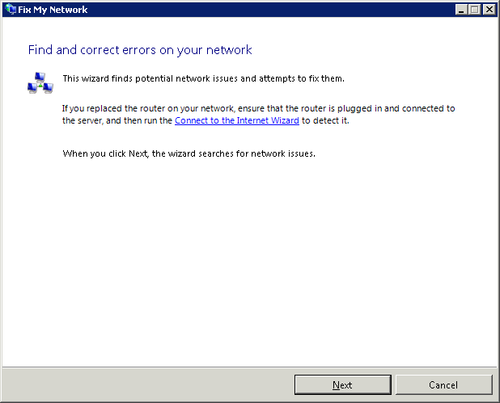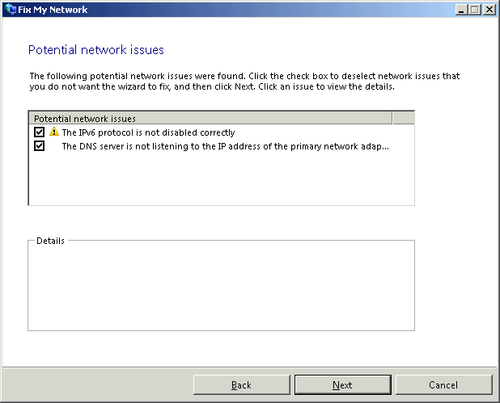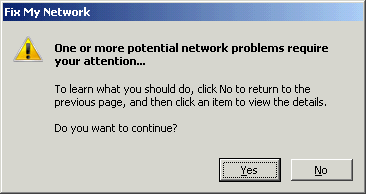In a perfect world, networks would never fail, no one would ever
have to change a network card, IP addresses would be automatically
assigned and never change, and no one would ever have to try to
troubleshoot a network connectivity problem. Well, IPv6 helps with some of
this, but we’re afraid that there’s still a long way to go until we
reach network nirvana. Until we do, however, there’s the Fix My Network Wizard (FMNW) in SBS.
Now, we have to say right up front that when we heard the name
for this new wizard, we were more than a little concerned. It sounded
a lot like something you might run on a home PC, with usually less
than optimal results. But then we remembered that for SBS 2003, the
SBS team had already created one of the best network configuration
wizards we’ve ever used—the Configure E-mail and Internet Connectivity Wizard.
Affectionately known as the CEICW (say that fast three times), the CEICW was a sort
of one-stop shop for resetting all your network settings back to where
they belonged. The CEICW was really good at what it did, but it did
have some limits. It couldn’t tell that your IP address had changed,
it didn’t recognize that your router wasn’t responding, and it
neglected to do a few other things that we’d sort of wished it did.
There were also times when you needed to run a different wizard or
actually resort to using the native Windows Server tools.
With the FMNW in SBS 2011, the SBS team has taken the concept of
the CEICW and extended and improved it significantly. The actual
initial configuration of Internet domain name and email, along with
public DNS names, have been separated out as discrete tasks with their
own wizards, which makes a lot of sense. After you’ve done those, they
really aren’t likely to change all that much. But it’s all the other
things that seem to go wrong with networking.
The FMNW, shown in Figure 1, is located on
the Connectivity page of the Network section of the Windows
SBS Console. The FMNW can identify, and in most cases fix, problems
with DHCP, DNS, logons, network access (both local and remote),
Internet connectivity, RWA, email, and VPNs. In some cases, you might
need to run the wizard multiple times, and if you have UPnP disabled
on your router, you’ll need to make any router changes that it
identifies yourself, manually.

When we ran it on our network, which had IPv6 disabled, we got
the Potential Network Issues page shown in Figure 2.

Now we expected this, because we deliberately disabled IPv6,
knowing that a missing or misconfigured IPv6 is the number one source
of the trouble calls to Microsoft Customer Support when Windows Small
Business Server 2008 has problems. The Wizard worked away for 10 to 15
seconds, and then gave us the results page shown in Figure 3.

This looks like all is well. But you should
always run the wizard a second time whenever you
find an issue. Because sometimes it takes two or more tries to fix all
the problems, and it often can’t even see a problem until it fixes
something else that is blocking. So, even though all looked well, we
ran the FMNW again, and result is shown in Figure 4.

Oops. OK, let’s run it again. Now it says that there’s some
stuff we’re going to have to do ourselves, as shown in Figure 5.

So we click Yes and return to the Potential Network Issues page. The first item is highlighted, and we’re
directed in the Details section to a Microsoft article with details on
how to fix it, as shown in Figure 6.

So, we go to the page, where it tells us we shouldn’t really
ever need to disable IPv6, but if we absolutely insist on disabling
it, here’s the proper way to do it. All in all, just better to not
disable it in the first place. Fix the IPv6 issue, and re-run the
FMNW. You should run it until you get either a completely green check
on issues, or the only issues left are issues you’ve already decided
you don’t want the wizard to fix (such as configuring the router or
firewall).
The one limitation of the FMNW is that it won’t run successfully
if you have more than a single network card enabled on your SBS
server. Because that’s not a supported configuration, the wizard
reports the issue and offers to disable the extra NIC—not a great
idea, because it could well disable the wrong one. Our solution is to
simply disable the NIC prior to running the Fix My Network Wizard on
our production network, which does have more than one network card in
the server because of the unusual networking requirements here with
all of our test networks.